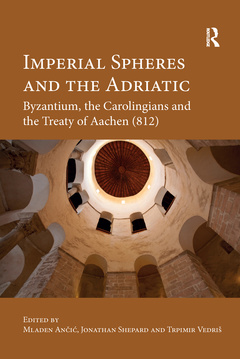Imperial Spheres and the Adriatic Byzantium, the Carolingians and the Treaty of Aachen (812)
Coordonnateurs : Ančić Mladen, Shepard Jonathan, Vedriš Trpimir

Although often mentioned in textbooks about the Carolingian and Byzantine empires, the Treaty of Aachen has not received much close attention. This volume attempts not just to fill the gap, but to view the episode through both micro- and macro-lenses. Introductory chapters review the state of relations between Byzantium and the Frankish realm in the eighth and early ninth centuries, crises facing Byzantine emperors much closer to home, and the relevance of the Bulgarian problem to affairs on the Adriatic. Dalmatia?s coastal towns and the populations of the interior receive extensive attention, including the region?s ecclesiastical history and cultural affiliations. So do the local politics of Dalmatia, Venice and the Carolingian marches, and their interaction with the Byzantino-Frankish confrontation. The dynamics of the Franks? relations with the Avars are analysed and, here too, the three-way play among the two empires and ?in-between? parties is a theme. Archaeological indications of the Franks? presence are collated with what the literary sources reveal about local elites? aspirations. The economic dimension to the Byzantino-Frankish competition for Venice is fully explored, a special feature of the volume being archaeological evidence for a resurgence of trade between the Upper Adriatic and the Eastern Mediterranean from the second half of the eighth century onwards.
1. Introduction: Circles Overlapping in the Upper Adriatic, Jonathan ShepardPART ONE: THE FRANKS MOVE EAST 2. The Treaty of Aachen: How Many Empires?, Mladen Ančić 3. Aemulatio imperii and the South-Eastern Frontier of the Carolingian World, Ivan Majnarić 4. Imperial Politics and its Regional Consequences: Istria between Byzantium and the Franks 788–812, Peter Štih PART TWO: BYZANTIUM IN TURMOIL 5. A Resurgent Empire? Byzantium in the Early 800s, Panos Sophoulis 6.Franks and Bulgars in the First Half of the Ninth Century, Angel Nikolov 7. Dangerous Neighbours: the Treaty of Aachen and the Defeat of Nikephoros I by the Bulgars in 811, Daniel Ziemann PART THREE: CIRCLES OVERLAPPING IN THE NORTHERN ADRIATIC 8. Aachen, Venice and Archeology, Sauro Gelichi 9. Patriarchs as Patrons: the Attribution of the Ciboria in Santa Maria delle Grazie at Grado, Magdalena Skoblar 10. Holding the Aquileian Patriarchate’s Title: the Key Role of Local Early Ninth-Century Hagiography, Marianna Cerno PART FOUR: DALMATIA: THE LAND IN BETWEEN 11. Post-Roman Dalmatia: Collapse and Regeneration of a Complex Social System, Danijel Dzino 12. One More Renaissance? Dalmatia and the Revival of the European Economy, Neven Budak PART FIVE: PANNONIA BENEATH THE SURFACE 13. What did the Treaty of Aachen do for the Peoples of the Carpathian Basin?, Béla Miklós Szőke 14. Lower Pannonia before and after the Treaty of Aachen, Hrvoje Gračanin 15. Changing Political Landscapes in the Ninth-Century Central Carpathian Basin: Interpreting Recent Settlement Excavation Data, Miklós Takács PART SIX: THE CHURCH BETWEEN ROME AND CONSTANTINOPLE 16. Rome and the Heritage of Ancient Illyricum in the Ninth Century, Maddalena Betti 17. Dalmatian Bishops at the Council of Nicaea in 787 and the Status of the Dalmatian Church in the Eighth and Ninth Centuries, Predrag Komatina 18. New Evidence for the Re-establishment of the Adriatic Dioceses in the Late Eighth Century, Ivan Basić 19. Amalarius’ Stay in Zadar Reconsidered, Trpimir Vedriš
Mladen Ančić is Professor of History at the Universities of Zadar and Zagreb. He has published on the Hungarian-Croatian kingdom and Bosnia in the fourteenth century, the medieval city of Jajce, and on historiography and nationalism.
Jonathan Shepard was Lecturer in Russian History at the University of Cambridge. Co-author of The Emergence of Rus with Simon Franklin, his edited volumes include The Cambridge History of the Byzantine Empire.
Trpimir Vedriš is Assistant Professor of Medieval History at the University of Zagreb. His co-edited volumes include Saintly Bishops and Bishops’ Saints (with John Ott) and Cuius Patrocinio Tota Gaudet Regio (with Stanislava Kuzmová and Ana Marinković).
Date de parution : 06-2020
15.6x23.4 cm
Date de parution : 09-2017
15.6x23.4 cm
Thème d’Imperial Spheres and the Adriatic :
Mots-clés :
Leo III; Frankish Empire; Byzantine; Avar Khaganate; Medieval Eastern Europe; Frankish Realm; Charlemagne; Muslim World; Jonathan Shepard; Annales Regni Francorum; Ivan Majnarić; Grave Assemblages; Peter Štih; Eastern Adriatic Coast; Panos Sophoulis; Dalmatian Bishops; Angel Nikolov; Eastern Adriatic; Daniel Ziemann; Suidae Lexicon; Sauro Gelichi; Northern Adriatic; Magdalena Skoblar; Carpathian Basin; Marianna Cerno; Lower Pannonia; Danijel Dzino; Dalmatian Towns; Neven Budak; Bulgar Ruler; Béla Mikls Szőke; Southern Pannonia; Hrvoje Granin; Dalmatian Hinterland; Mikls Tak; Constantinopolitan Church; Maddalena Betti; Episcopal Lists; Predrag Komatina; Frankish Influence; Ivan Basić; Santa Maria Delle Grazie; Trpimir Vedriš; South Eastern Frontier; Row Grave Cemeteries; Imitatio Imperii



